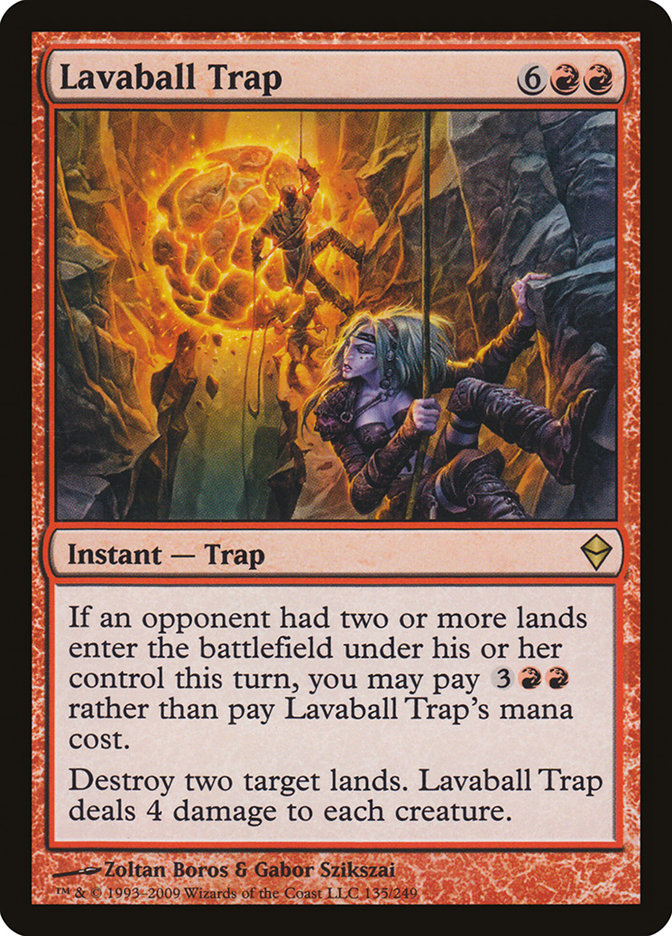Armadilha de Bola de Lava Carta MTG
| Custo de mana | |
| Custo convertido de mana | 8 |
| Raridade | Rara |
| Tipo | Mágica Instantânea — Armadilha |
| Lançamento | 2009-10-02 |
| Expansão símbolo | |
| Expansão nome | Zendikar |
| Expansão código | ZEN |
| Número | 135 |
| Frame | 2003 |
| Layout | Normal |
| Border | Preta |
| Ilustrado por | Zoltan Boros & Gabor Szikszai |
Texto da carta
Se um oponente teve dois ou mais terrenos que entraram no campo de batalha sob o controle dele neste turno, você pode pagar {3}{R}{R} em vez de pagar o custo de mana de Armadilha de Bola de Lava. Destrua dois terrenos alvo. Armadilha de Bola de Lava causa 4 pontos de dano a cada criatura.
Texto da carta Armadilha de Bola de Lava
Se um oponente teve dois ou mais terrenos que entraram no campo de batalha sob o controle dele neste turno, você pode pagar {3}{R}{R} em vez de pagar o custo de mana de Armadilha de Bola de Lava. Destrua dois terrenos alvo. Armadilha de Bola de Lava causa 4 pontos de dano a cada criatura.
Onde comprar
Se você deseja comprar um cartão Armadilha de Bola de Lava MTG de um conjunto específico como Zendikar, há diversas opções confiáveis a serem consideradas. Uma das principais fontes é a loja de jogos local, onde muitas vezes você pode encontrar boosters, cartas individuais e decks pré-construídos de conjuntos atuais e de alguns conjuntos anteriores. Eles geralmente oferecem o benefício adicional de uma comunidade onde você pode negociar com outros jogadores.
Para um inventário mais amplo, especialmente de conjuntos mais antigos, mercados on-line como TCGPlayer, Card Kingdom e Card Market oferecem seleções extensas e permitem que você pesquise cartas de conjuntos específicos. Grandes plataformas de comércio eletrônico, como eBay e Amazon, também têm listagens de vários vendedores, o que pode ser um bom lugar para procurar produtos lacrados e achados raros.
Além disso, o site oficial do Magic geralmente tem um localizador de lojas e listas de varejistas para encontrar a Wizards of the Produtos licenciados pela Costa. Lembre-se de verificar a autenticidade e a condição dos cartões ao comprar, especialmente de vendedores individuais em mercados maiores.
Abaixo está uma lista de alguns sites de lojas onde você pode comprar os Armadilha de Bola de Lava e outras cartas MTG:
 COMPRAR
COMPRAR BurnMana é parceiro oficial da TCGPlayer
- eBay
- Card Kingdom
- Card Market
- Star City Games
- CoolStuffInc
- MTG Mint Card
- Hareruya
- Troll and Toad
- ABU Games
- Card Hoarder Magic Online
- MTGO Traders Magic Online
Veja produtos de MTG
Legalidades
Magic the Gathering formats where Armadilha de Bola de Lava has restrictions
| Formato | Legalidade |
|---|---|
| Commander | Válida |
| Legacy | Válida |
| Modern | Válida |
| Oathbreaker | Válida |
| Vintage | Válida |
| Duel | Válida |
| Predh | Válida |
| Penny | Válida |
Regras e informações
O guia de referência para regras de cartas de Magic: The Gathering Armadilha de Bola de Lava fornece decisões oficiais, quaisquer erratas emitidas, bem como um registro de todas as modificações funcionais que ocorreram.
| Data | Texto |
|---|---|
| 2009-10-01 | All creatures are dealt damage, not just ones controlled by the targeted lands’ controller(s). |
| 2009-10-01 | Casting a Trap by paying its alternative cost doesn’t change its mana cost or converted mana cost. The only difference is the cost you actually pay. |
| 2009-10-01 | Effects that increase or reduce the cost to cast a Trap will apply to whichever cost you chose to pay. |
| 2009-10-01 | If both targeted lands are illegal targets by the time Lavaball Trap resolves, the entire spell doesn’t resolve. No creatures are dealt damage. |
| 2009-10-01 | You may ignore a Trap’s alternative cost condition and simply cast it for its normal mana cost. This is true even if its alternative cost condition has been met. |
| 2009-10-01 | You may target any two lands, not just ones that entered the battlefield this turn. |
